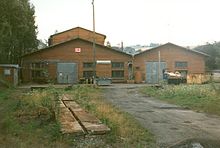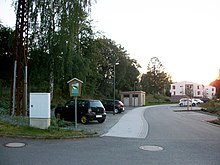Thum train station
| Thum | |
|---|---|
|
Reception building (2000)
|
|
| Data | |
| Operating point type | former train station |
| Location in the network | former separation station |
| opening | April 18, 1906 |
| Conveyance | December 31, 1975 |
| location | |
| City / municipality | Thum |
| country | Saxony |
| Country | Germany |
| Coordinates | 50 ° 40 '8 " N , 12 ° 57' 8" E |
| Height ( SO ) | 507.39 m |
| Railway lines | |
|
|
| Railway stations and stops in Saxony | |
The Thum station was an operating point of the narrow-gauge railway Schönfeld-Wiesa-Meinersdorf and the line from Wilischthal , which flows in here, in the municipality of the city of Thum in Saxony. Until it was closed in 1975, Thum was the operational center of the two lines, which have become known as the "Thumer Netz", especially among railway enthusiasts.
history
Thum stop
Thum got its first train station on December 14, 1886 with the opening of the line from Wilischthal. The operations center had four tracks with a total of nine points. A reception building had not been built, the task of which was taken over by the goods shed with an attached office. Facilities for restoring the locomotives did not exist. As a result of the construction of the Geyer line, where a new train station was built, the operating site was closed in 1906.
Thum train station
The Thum station went into operation on April 18, 1906, when a train from Wilischthal first reached the station, which was still under construction. On May 1, 1906, the Geyer line was finally put into operation, which was extended to Meinersdorf on October 1, 1911. At that time the station had eleven tracks, three of which were used for tourist traffic.
The station building was a simple type construction, as it was built at the same time in other train stations in Saxony. In the corner of the lines to Meinersdorf and Wilischthal there was originally a four-room boiler house , which in 1911 had been expanded by two stalls. There was a small car workshop at the exit to Schönfeld-Wiesa. In addition, an outbuilding with free access, a goods shed, a loading gauge, a bridge scale and a side loading ramp with a loading street were built. At the end of the platform in the direction of Geyer, there was a water crane between the tracks .
The station had entry form signals on the three converging routes , but no exit signals. Like the switches on the main line, they were operated remotely using a crank mechanism in an extension to the station building.
The track system of the station has remained largely unchanged over the years. A new car repair workshop was built next to the boiler house in 1926 and 1927. The now dilapidated boiler house was replaced in 1934 after the commissioning of the class 99.73-76 locomotives by a new building at the same location, which had eight locomotive stands on four tracks. It was the largest of the Saxon narrow-gauge railways . He also received an extension with two tracks for car repairs.
With the traffic boom after the Second World War , Thum was elevated to a “complex train station” in 1947. All stations on the narrow-gauge lines leading to Thum, including the connecting stations to the standard-gauge network, were subordinate to the station. A station dispatcher coordinated the provision of transport space, special services and leader locomotives.
After the closure of the narrow-gauge railways between 1967 and 1975, the Thum station facilities were dismantled in July 1977 by the Annaberg-Buchholz railway maintenance department. The workshop buildings were still used until 1995 as a refurbishment workshop for the Reichsbahn repair shop in Karl-Marx-Stadt (from 1990: Chemnitz). In October 2013 the building was demolished for the planned new construction of a nursing home.
Thum depot
The locomotive shed at Thum station, which has existed since 1934, had, in addition to the four locomotive repair tracks and two wagon repair tracks, an outbuilding for the accommodation of the operating staff with washrooms and other service rooms. In front of the shed, a gantry crane with a load capacity of 1 t was erected.
After the Second World War, the traffic on the narrow-gauge railways in the Ore Mountains , especially on the routes of the Thumer Netz, the Pöhlatalbahn and the Fichtelbergbahn , increased sharply in the course of uranium mining. Initially, the Thum and Jöhstadt locomotive stations were still part of the Annaberg-Buchholz depot . Due to the strong increase in the number of locomotives in the respective locations, the new Thum depot was founded on February 1, 1949. In addition to the locomotives and wagons for the Thumer Netz and the Preßnitztalbahn, the Hetzdorf – Eppendorf line was subject to this from June 1, 1959 . In 1954 a social building with a kitchen and dining room was built, and a barrack was built next to the car workshop. In addition to the tracks on the Meinersdorf line, various car bodies from standard gauge wagons were used as locomotive management . In the 1960s, the locomotives of the Fichtelbergbahn still came to the Thum depot. In the course of the meanwhile normalizing transport services and the initial cessation of operations on various narrow-gauge railway lines, the Thum depot was dissolved on January 1, 1967 and converted into an operation site of the Aue depot . The site itself was closed on January 1, 1974 when traffic on the Thumer network ceased. The remaining locomotives in Thum, Oberwiesenthal, Jöhstadt and Schönfeld-Wiesa (the Eppendorf locomotive station had meanwhile been closed due to the closure of the line) were now subordinate to the station in Annaberg-Buchholz , a branch of the Aue depot. The structure of the Thum depot changed so much after the closure that the former locomotive and wagon workshop only received one entrance gate each. The other gates were walled up and replaced with windows.
Branch offices of the Thum depot existed in Eppendorf , Jöhstadt and Oberwiesenthal .
Initially, in addition to a few construction locomotives, mainly machines of the type IK were used. The Thum locomotive station is known for the use of a class II K (new) locomotive with the number 62 A / B in the first years before and during the First World War . Later four locomotives of the III K series were used, which were returned after the 99.51-60 series were received. Mainly the locomotives of the series 99.73-76 and 99.77-79 were used here from 1933 . The 99.51–60 was mainly used on the Hetzdorf – Eppendorf and Wolkenstein – Jöhstadt line, while the 99.73–76 and the 99.77–79 ran exclusively on the routes around Thum and on the Cranzahl – Oberwiesenthal route. Five locomotives of the VK series played a minor role here , and they came to Thum after the Heidenau – Kurort Altenberg railway had been re - tracked. After 1942 these machines were lost due to front use. Locomotives of the VI K series also ran in Thum, but were transferred to the Wilsdruffer network for reasons of type adjustment .
literature
- Dieter Bäzold: The Thumer Narrow Gauge Network . Bufe-Fachbuch-Verlag, Egglham 1993, ISBN 3-922138-51-9 .
- Stephan Häupel, Eberhard Schramm: Narrow gauge railways around Thum. Kenning Verlag, 2002, ISBN 3-933613-39-6 ; Pp. 114-125.
Web links
- www.stilllege.de
- Data, pictures and plans on www.sachsenschiene.de
- Website about the history of the narrow-gauge network in Thum
Individual evidence
- ↑ Track plan of Thum train station from 1911 at www.sachsenschiene.net
- ↑ historical photo of the Thum train station on www.sachsenschiene.net
- ↑ Track plan of Thum train station from 1956 on www.sachsenschiene.net
- ↑ Freie Presse Online : Investment - Locomotive shed will be demolished for the DRK , accessed on February 17, 2014.
- ↑ a b Locomotive stationing on the website about the history of the Thumer narrow-gauge network ( Memento from February 9, 2008 in the Internet Archive )




